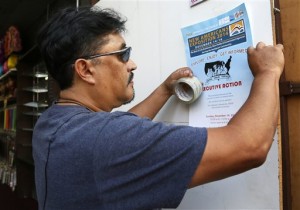Immigrants flock to workshops after Obama reprieve

This Dec. 10, 2014 photo shows Tony Bernabe posts a flier in downtown Los Angeles advertising a massive information session scheduled for this weekend to tell immigrants more about President Barack Obama’s executive actions on immigration. Immigrant advocates have been holding workshops in churches, schools and meeting rooms across the country to dispel rumors, ward off fraud and help immigrants here illegally determine if they qualify to apply for a work permit and protection from deportation. (AP Photo/Nick Ut)
LOS ANGELES—In small-town community centers, schools, churches and a vast city convention center, immigrant advocates are spreading the word about President Barack Obama’s plan to give millions of immigrants living in the US illegally a temporary reprieve.
The November announcement promising work permits and protection from deportation made a splash, but lawyers say the events are crucial to dispel rumors about eligibility, ward off fraud, and help immigrants determine what they might need to apply.
Immigrants are eager to see if they qualify for Obama’s executive actions to spare nearly 5 million people from deportation and to refocus enforcement efforts on criminals.
At least 20 states have filed a lawsuit to try to block the measure, which aims to benefit immigrants who have been in the country illegally for more than five years and have children who are American citizens or permanent residency green card holders, along with some immigrants who entered the country illegally as children.
In Los Angeles, advocates are hosting an information session for as many as 10,000 people at the city’s convention center Sunday.
Article continues after this advertisement“After this big forum, we’re going to have daily orientations. That is what we have to do in order to deal with the demand,” said Angelica Salas, executive director of the Coalition for Humane Immigrant Rights of Los Angeles.
Article continues after this advertisementFor immigrant advocates, the challenge is reaching prospective applicants in diverse communities that speak multiple languages and often know little about the United States’ byzantine immigration laws. While some immigrants find strength in numbers, others shy away from public meetings because of fear or stigma over their immigration status.
At recent workshops and on telephone hotlines, immigrants have questioned advocates about who will qualify and what documents they will need. Many want to know how they can prove their identity after living under the radar for so long, Salas said.
At a recent forum at a San Diego community center, an immigration attorney fielded questions for two hours, and many hands were still raised when time ran out.
Anahi Maldonado, a 32-year-old mother of two American-born children, said she attended to verify that she and her husband would qualify for the program. She’s been living in the US for 14 years after crossing the border from Mexico and wanted to ensure she didn’t need a visa to apply.
“The thing is, sometimes someone has questions that the president is not going to answer,” said Maldonado, adding that she also wondered if she would need a good conduct letter from police, and how she could get one since she didn’t have valid immigration papers.
Immigrant advocates are doling out whatever information they have, much of it based on their experiences with a 2012 program to assist US-educated immigrant children. But there is still much that is unknown, and no application form yet.
Advocates are warning immigrants not to pay anyone to get in line to apply and to avoid being duped into filling out fake applications.
Many are also planning one-on-one consultations to help immigrants determine if they’re eligible and if that’s their best shot at immigration relief, since sometimes people may qualify for a visa or other benefits.
Michelle Saucedo, a legal advocate for Asian Americans Advancing Justice in Los Angeles, said Asian immigrants are more likely to turn out for one-on-one consultations than group sessions because some feel a sense of shame over their immigration status. When advocates advertised large workshops about the 2012 program in the Chinese community, only one or two people would show up, she said.
RELATED STORIES
Obama immigration order explained at Consulate ‘Talakayan’